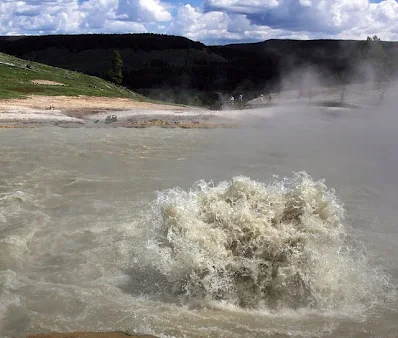Hot Springs: What is It, How Are Hot Springs Formed
Hot springs are natural phenomena where groundwater is heated by a geothermal heat source, such as magma or hot rocks deep beneath the Earth's surface. The heated water rises to the surface and emerges as a hot spring.
Hot spring is a spring that is produced by the emergence of geothermally heated groundwater from the Earth's crust. There are geothermal hot springs in many locations all over the crust of the earth.
How Are Hot Springs Formed
Hot springs are formed through a process involving the heating and circulation of groundwater. Here's a step-by-step explanation of how this occurs:
Water Infiltration:
Rainwater or melting snow seeps into the ground through cracks, faults, or porous rocks. This water travels deep into the Earth, beginning the journey toward becoming a hot spring.
Geothermal Heating:
As the water descends, it encounters the Earth's geothermal gradient, meaning temperature increases with depth. For every kilometer down, the temperature typically rises by about 25-30°C. In volcanic regions, magma chambers close to the surface can superheat the water, far exceeding the normal geothermal gradient.
Circulation of Heated Water:
Convection: When the water is heated, it becomes less dense and rises due to convection currents. This movement can be slow or fast, depending on the level of geothermal activity.
Formation of Underground Reservoirs:
In certain cases, the heated water is trapped beneath impermeable rock layers, forming an underground reservoir. If this trapped water finds an outlet to the surface, it emerges as a hot spring.
Pressure Build-Up and Artesian Systems
The heated water expands as it heats up, creating pressure. This, combined with the natural buoyancy of hot water, forces it toward the surface. In some cases, an artesian system is involved, where water is trapped between impermeable layers and pushed upward when a pathway to the surface opens.
Pathways to the Surface:
Hot water travels back up through cracks, faults, or fractures in the Earth's surface. A continuous circulation system, where cold water sinks, gets heated, and rises, can sustain a hot spring for extended periods.
Emergence at the Surface:
The heated water eventually reaches the surface, forming a hot spring. If the pathway is narrow or if the water is under high pressure, it may erupt as a geyser. However, in the case of hot springs, the water typically flows out continuously.
Mineral Dissolution and Deposition:
As the water travels underground, it dissolves minerals from surrounding rocks. When it reaches the surface and begins to cool or evaporate, these minerals precipitate out, sometimes forming colorful terraces or mounds, such as those at Mammoth Hot Springs (Yellowstone) or Pamukkale (Turkey).
Continuous Cycle:
This process is often ongoing, with fresh water continually infiltrating the ground, getting heated, and rising to the surface. As long as the geothermal heat source remains active and the water supply is not cut off by geological changes, this cycle can sustain hot springs for thousands of years.
 | |
|
Sources of heat
The water issuing from a hot spring is heated by geothermal heat, i.e., heat from the Earth's mantle. In general, the temperature of rocks within the earth increases with depth. The rate of temperature increase with depth is known as the geothermal gradient. If water percolates deeply enough into the crust, it will be heated as it comes into contact with hot rocks. The water from hot springs in non-volcanic areas is heated in this manner.
Steam Crepuscular rays at Mammoth Hot Springs
In active volcanic zones such as Yellowstone National Park, water may be heated by coming into contact with magma (molten rock). The high temperature gradient near magma may cause water to be heated enough that it boils or becomes superheated. If the water becomes so hot that it builds steam pressure and erupts in a jet above the surface of the Earth, it is called a geyser. If the water only reaches the surface in the form of steam, it is called a fumarole. If the water is mixed with mud and clay, it is called a mud pot.










